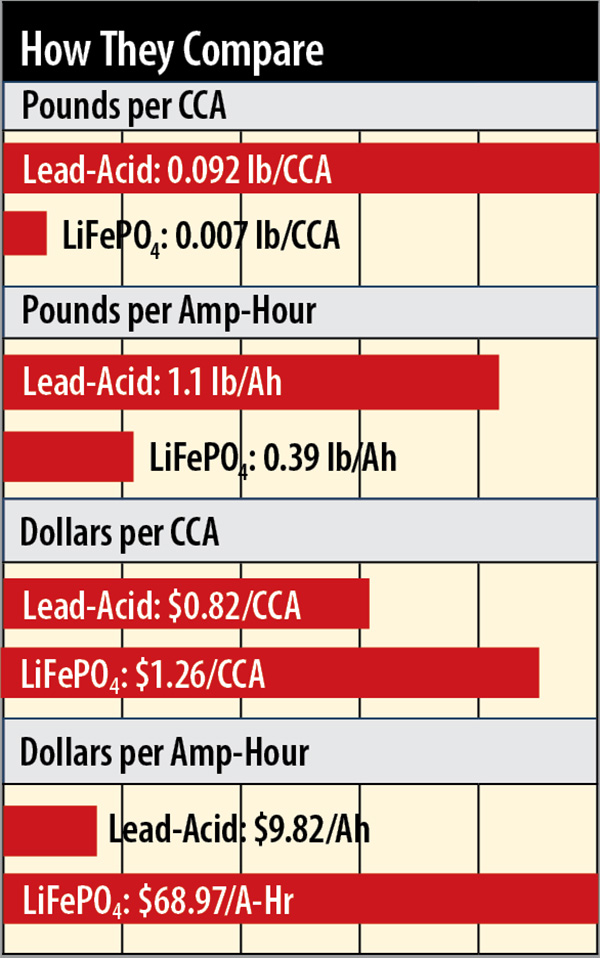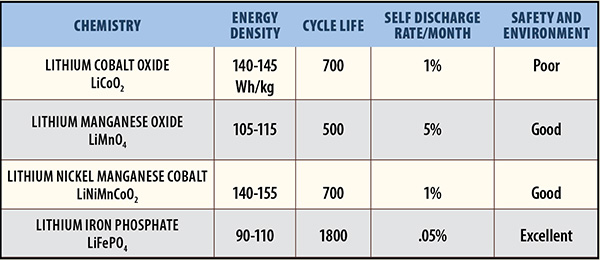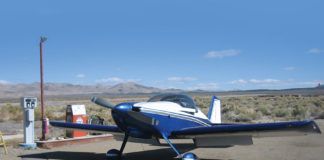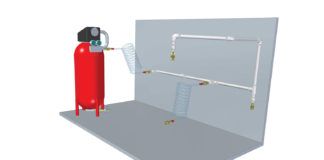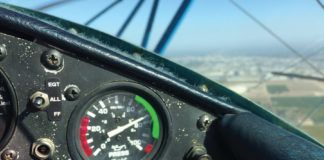I don’t know about you, but I love long solo cross-country flights. I let my mind wander while the mountains and the cities slowly pass under my wings. Of course, my mind occasionally wanders into strange places. I think about things like why am I carrying 25 pounds of lead around in the back of my airplane? I used a battery to start my engine before I took off and now it’s just sitting there reducing my useful load and consuming fuel for the entire flight.
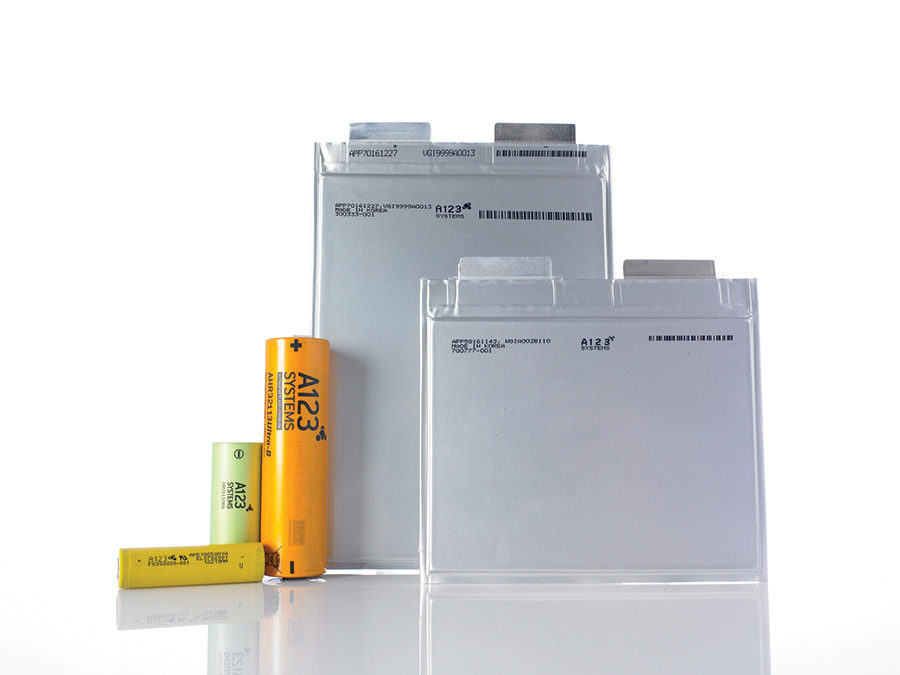
A123 has dominated the market in LiFePO4 cells of various designs. Most are 3.6-volt cells wired in arrays to produce the desired finished voltage.
I don’t want to downplay the safety factor that a battery provides. When a field coil wire broke off my alternator a couple of years ago, I was quite happy to have that dead weight in the back. But in all the hours I flew that airplane, that was the only time I really appreciated it. So, would I really fly without a battery? Probably not—and definitely not in the clouds.
So, what can I do to reduce the penalty I pay for hauling that capability around with me? The obvious solution is a lighter battery. The widely-used lead-acid (PbA) battery has been used to start engines for over a century because it has some useful characteristics. It can deliver a lot of current, which is needed to turn a starter motor for a short period, and it can survive repeated discharge/charge cycles. Because the same technology is widely used in the automotive world, it is relatively inexpensive and reliable. But it is heavy.
Battery technology has advanced a bit in the last century. One promising technology that you’ve heard about is lithium-ion chemistry and specifically lithium-iron-phosphate, also known as LiFePO4 or LFP. As a cathode material, this was first described in 1996 by John Goodenough at the University of Texas. The technology was further improved by researchers at MIT. Today, LFP is becoming increasingly popular in applications from cordless tools and appliances to electric vehicles. So, what could an LFP battery do for my airplane? What are the benefits and are there any risks?
An airplane battery has two jobs: it has to put out a lot of current to start the engine, and then it hangs around waiting to supply critical electrical components when and if the alternator takes a powder. We measure a battery’s performance in these tasks in terms of cranking power and standby capacity.
Cranking a cold engine requires a lot of torque. To generate a lot of torque, an electric motor needs a lot of current. So, we measure cranking power in terms of the amount of current (number of amps) the battery can deliver to the starter motor terminals when we turn the key. For lead-acid batteries, we measure this as cold cranking amps or CCA, which is the number of amps that can be delivered for 30 seconds before the battery voltage drops below 7.2 volts. The test is conducted at 0° F (-18° C).
While the CCA test is useful for comparing lead-acid batteries on an even playing field, it isn’t the best measure for evaluating the cranking ability of different battery technologies. The endpoint of the test is based on the voltage vs. state-of-charge (percent of full capacity) curve of the lead-acid technology. The voltage falls somewhat uniformly as the state of charge decreases. The LiFePO4 battery voltage, however, remains at a much higher level until the battery capacity is nearly depleted. So, the CCA test endpoint (7.2 volts) doesn’t really apply to LFP batteries.
LFP manufacturers use a C rating, which defines a maximum current as a proportion of the total capacity that can be drawn from the battery for a short period—typically 10 seconds—without damaging the cells. For instance, a 30C LFP battery can deliver amperage of 30 times the amp-hour capacity for up to 10 seconds and still be fully recharged. While peak current based on this C rating is not exactly comparable to the CCA of a lead-acid battery, it is a measure of the current available for the short period needed to start an engine.
So, how do these two technologies compare in terms of cranking power? We looked at a sample of conventional aircraft batteries which are summarized at right. Note that this is just a sampling, not all the batteries that are available.
Typical lead-acid aircraft batteries supply 200 to 250 CCA and weigh 20 to 30 pounds. One battery surveyed boasts 421 CCA and weighs 29 pounds. This translates to 0.15 to 0.08 pounds/CCA. We looked at 19 currently available LFP batteries (rated at 50C) and summarized nine of these in the chart below. Note that the data reveals more than a 90% weight saving for cranking power. That means I can pack 25 pounds of snacks in the cooler for my next long cross country.
Standby Capacity
OK, so I can save 90% of that dead weight if all I need to do is start the engine. What about the insurance of some stored energy to run the electrics in a pinch? Battery storage capacity is measured in amp-hours (Ah), which is the product of the current drawn (amps) and the time required to fully drain the battery (hours). For instance, if we draw 10 amps for an hour, we consume 10 Ah.
Our sample 12-volt lead acid aviation batteries revealed a capacity range of 18 to 32 Ah, weighing between 21 and 45 pounds. (Not all of these are charted, by the way.) The cost (in weight) of this storage capacity ranges from 0.98 to 1.41 (average 1.17) pound/Ah. The 19 LFP batteries we looked at had a wider capacity range (2.6 to 25 Ah) and averaged 0.42 pound/Ah, a 64% weight reduction.
We didn’t find a lot of available products that provide both high cranking current and storage capacity equivalent to lead-acid starting batteries. A number of LFP batteries aimed at the automotive market provide significantly more storage capacity, but limit the maximum (cranking) current to a 5C rate. But that isn’t necessarily bad. A 100 Ah LFP battery can supply 500 A cranking power (twice the average lead-acid CCA) for starting and supply three to four times the stand-by capacity in an emergency for about the same weight as the lead-acid battery. That is a real alternative to carrying a back-up alternator.
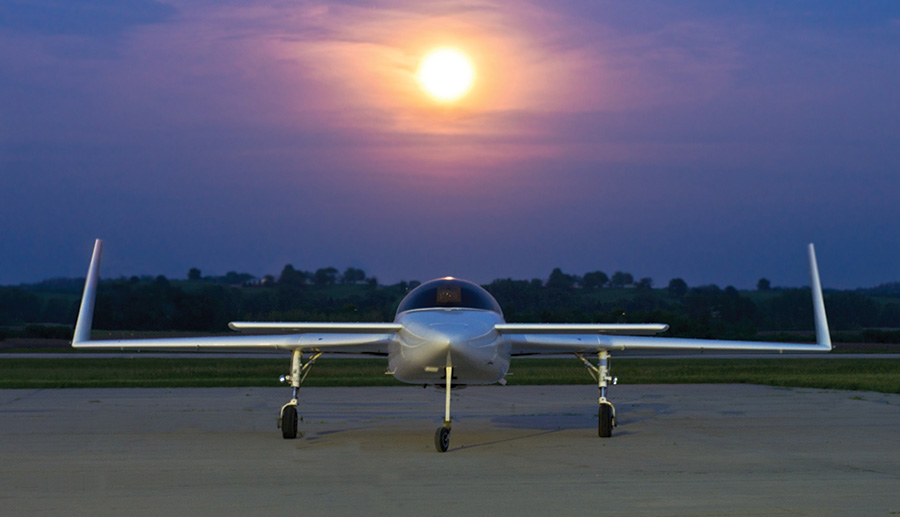
When Mitch Hargin dropped an Aerovoltz 16-cell EV02 into his E-Racer, the weight he saved allowed an extra 30 minutes of fuel and added 75 nautical miles to his range.
Cost
Now for the bad news. LFP technology isn’t cheap—yet. For the batteries surveyed, the average cost per cranking amp is $1.26. This compares to about $0.82/CCA for PbA, based on current prices. In other words, you’re going to pay about 50% more for the same cranking power if you choose the LFP battery.
And how much will you pay for that standby power? The LFP batteries average about $69/Ah compared to roughly $9 to $10/Ah for conventional batteries. That translates to a premium of $1,450 for a typical 25 Ah storage capacity, and that doesn’t include the gold-plate option.
So, does it make economic sense to take the plunge and switch to LFP? Maybe. For the typical single-engine GA aircraft, for which the battery is sized for standby power, probably not yet. Assume you want 25 Ah of stand-by energy. A 2500-pound aircraft with a lift to drag ratio (L/D) of 9.0 (typical Cessna 172) and cruise fuel burn of 12 gallons per hour will save about 60 cents per flight hour from the weight saving. This will save less than $120 for a year in which you fly 200 hours. That’s a payback of about 10 years, probably exceeding the life of the battery. These economics could change radically, however, if you put a premium on useful load. If you were flying a cargo of drugs or gold, for instance, that extra 20 pounds might be very profitable.
But, when standby capacity is not the design criteria and the battery is sized for cranking current, the economics change dramatically. A 50C-rated LFP battery sized to supply 250 A to the aircraft described above would pay for itself in about one year. This criterion might apply to a multi-engine aircraft that has redundant alternators or an aircraft that doesn’t have much of an electrical system. So, there are conditions that favor LFP technology.
Another thing to remember is that LFP is an emerging technology that is finding use in a wide range of products, from appliances to computers and electric vehicles. That means that the price of these products should fall as production volumes increase. So, if the economics don’t work for you today, wait around. They may be better next year.
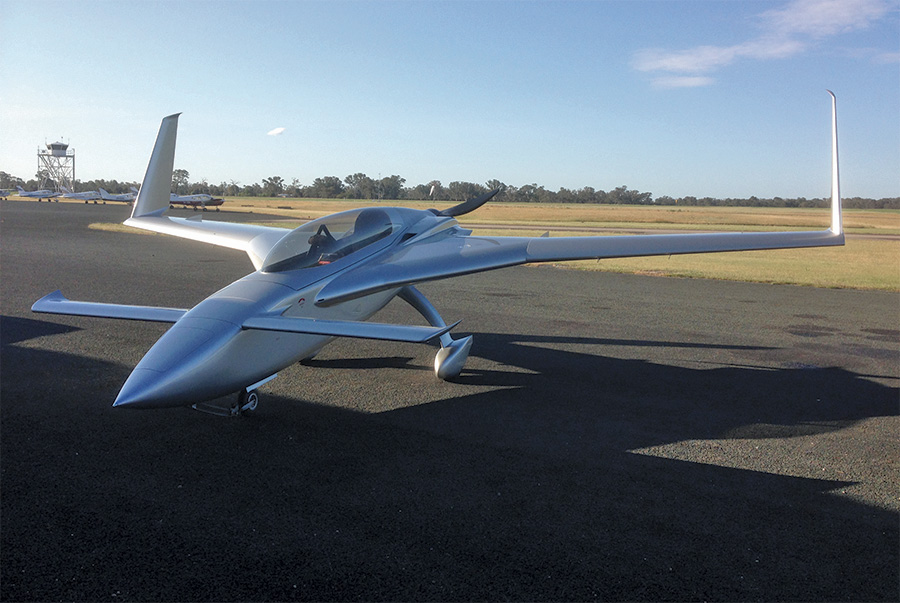
Wayne Blacker replaced his lead-acid Odyssey PC680 (16 A-Hr, 15.4 pounds) with an RCE 12 V (16.1 A-Hr, 6.3 pound) LFP battery and saved nearly 10 pounds in his LongEZ.
Safety and Other Considerations
Many of us cringe a bit when we hear lithium and battery in the same sentence. We’ve heard horror stories about lithium-ion batteries catching fire and scorching the lap of their laptop user. But lithium-iron-phosphate is a different animal than other lithium-ion chemistries. The iron-phosphate chemical bond is stronger than the cobalt-oxygen bond, making the LFP cathode structure more tolerant to damage from short circuit and overheating.
Once fully charged, however, any battery can only dissipate overcharge energy as heat, which can damage the battery, For this reason, many manufacturers recommend some charge-limiting system or build one into their battery pack to prevent this occurrence.
Because lead-acid batteries are everywhere, we tend to forget that they have their own issues. The obvious risk is the release of hydrogen gas when charging. This characteristic requires that the battery is located in a well-ventilated space. The presence of liquid acid in flooded batteries always presents a burn or eye damage hazard to maintenance personnel. Finally, the acid and vapors from the battery can corrode nearby metal components and, in extreme cases, damage structure or degrade electrical connections.
The recent grounding of the Boeing 787 fleet following two lithium-ion battery fires has shed unfavorable light on the technology. However, the 787s use lithium cobalt oxide chemistry, which is considered to be less stable than LiFePO4. Still, even the iron-phosphate has some issues. In a well-suppressed event, Cessna lost a Citation jet to a battery fire on the ground. The aircraft was equipped with LiFePO4 cells from the well-known manufacturer A123. Neither Cessna nor A123 has revealed any technical data on the cause for the fire, but an AD was issued ordering removal of the LiFePO4 pending a solution.
While these fires are attention getting, they don’t necessarily mean the technology is hopelessly flawed. There are lead-acid battery fires, too. Bottom line: We don’t have enough reliable data to judge whatever risks may exist for either battery technology.
But we do know about the benefits of LFP batteries compared to lead-acid products: They charge much more quickly and they discharge much more slowly when not in use. The lower internal resistance enables them to be recharged in minutes, rather than hours for lead-acid batteries. Also, when sitting in the hanger unused for a month, an LFP battery will lose about 5% of its stored capacity, compared to 20% for a lead-acid product. That could save you an extra trip to the airport to charge the battery.
Testimonials
LFP batteries are marketed for motorcycle and auto racing and are now finding their way into homebuilts. Wayne Blacker flies a Long-EZ powered by a Lycoming IO-360. He replaced his lead-acid Odyssey PC680 (16 Ah, 15.4 pounds) with an RCE 12 V (16.1 Ah, 6.3 pounds) LFP battery and saved nearly 10 pounds. He is set up with a backup alternator and didn’t change the charging system in any way except to modify the battery mount for the smaller LFP unit. He likes the quality of construction and customer support provided by RCE in Taiwan, and he is so impressed with the new battery that he is considering replacing the second alternator with a back-up battery.
About six months ago, Mitch Hargin dropped an Aerovoltz 16-cell EV02 (www. aerovoltz.com) into his E-Racer, replacing a heavy Walmart battery. He’s driving an IO-320 and says the weight saving allows him to add four gallons of extra fuel. The extra fuel adds 30 minutes to his endurance and 75 nautical miles to his range. Although he hasn’t gone through an Iowa winter yet, he has started up with the air temperature as low as 37° F with no problems.
Conclusion
LiFePO4 batteries are finding their way into a lot of consumer and commercial products because of their low weight, large storage capacity, their ability to charge and discharge quickly, and their relative safety compared to other high energy-density technologies. Although the technology is still in its infancy, it is widely favored for use in electric vehicles and that application will likely drive down the cost of the technology in the near future. At the moment, these batteries are a bit pricey for a typical recreational Cessna driver. But under the right conditions, existing products already make economic sense. I’m looking real hard at them for my twin. As the technology gains more widespread use in other (especially automotive) markets, the price will continue to fall, making them more appealing to a larger circle of airplane owners. So, don’t be surprised to find LiFePO4 in your future.

![]()
Gordon Alling secured his wife’s permission to fly airplanes 14 years ago and hasn’t touched down since. He’s based at Fredericksburg, Virginia where he has stabled a Cessna Cardinal and a Beech Sundowner. He has degrees in aerospace and mechanical engineering and operates a small engineering consulting company. Alling is building a Rutan Defiant push-pull twin. He chose the Defiant as a test bed for experimental engines, of which he is particularly fond.


